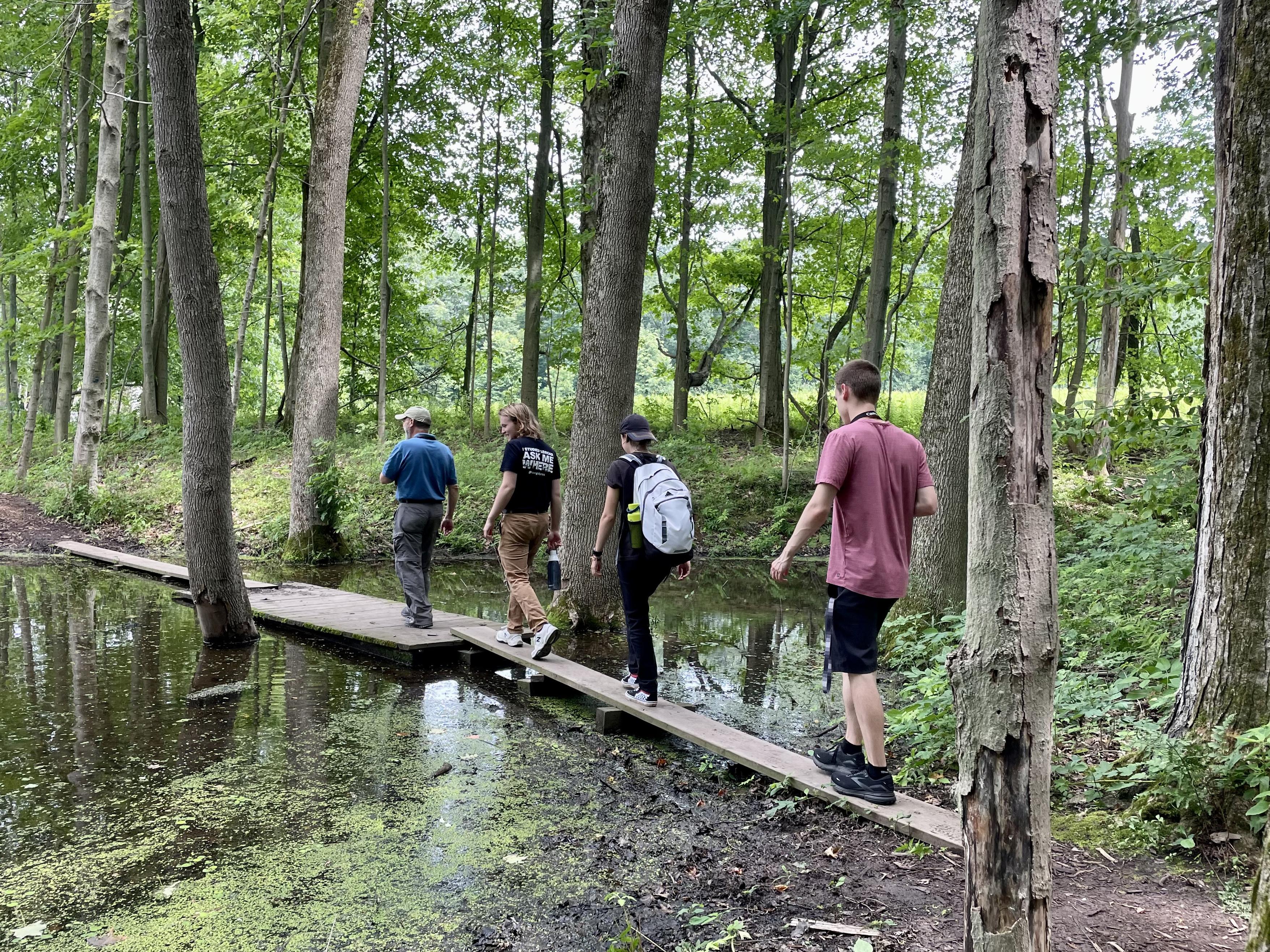The faculty-student collaboration “Sterling Nature Center: A Living History” will make its film debut at SUNY Oswego at 5:30 p.m. on Wednesday, March 27, in the Marano Campus Center auditorium (room 132). Walking a trail during the production are, from left, Jim D'Angelo, director of Sterling Nature Center, with student filmmakers Wells Liscomb and Lauren Smith (both seniors) and Ryan King (who graduated in 2023).
A film collaboration between students, faculty and community members will debut at SUNY Oswego at 5:30 p.m. on Wednesday, March 27, in the Marano Campus Center auditorium (room 132). “Sterling Nature Center: A Living History” explores the creation of a 1,400-acre nature preserve 10 miles west of SUNY Oswego.
“Today, people know Sterling Nature Center as a nice place to hike, go to the beach, see the heron rookery,” says English and creative writing professor Laura Donnelly, one of the executive producers of the film, “but most people don’t realize how hard the local community had to fight for this 50 years ago.”
The March 27 event includes a screening of the 15-minute film followed by a panel discussion with filmmakers and community members. The event is free and open to all members of campus and local communities. Refreshments will be provided.
The film tells the story of how Rochester Gas and Electric bought large tracts of land in Sterling, New York, during the early 1970s, and how the community responded over the following decades. Journalist Barbara Bartholomew, who first broke this story 50 years ago, is one of the people interviewed in the film. Bartholomew notes that citizen protests against the power plant aligned with increasing environmental awareness.
“Fifty years ago, people were just beginning to wake up to the treasure our planet is: think Rachel Carson, ‘Silent Spring.’ By the 1970s, we finally had Earth Day,” Bartholomew recalled.
Working for The Oswego Palladium-Times and other local papers, she reported on two decades of challenges to this land along Lake Ontario, including proposals to make it a waste management site or a low-level toxic waste dump, and saw firsthand the community activism that led to the creation of a nature center instead.
Other community members interviewed in the film include June Ouellette, owner of Ontario Orchards and longtime president of the Friends of Sterling Nature Center; Charlie Itzin, vice president for the Friends of Sterling Nature Center and a retired Oswego professor; Susie Parsons, the Sterling Town historian; and Jim D’Angelo, the director of Sterling Nature Center.
“All of these people have deep ties to the local community and were invaluable in making the film,” Donnelly said. Parsons and Itzin, along with Susan P. Gateley, have written a book about this era in Sterling history, which will be available for purchase at the film screening.
Student experiences
Oswego students Lauren Smith and Wells Liscomb and recent Oswego alum Ryan King were a core part of making the documentary a reality.
“I’ve walked my dog at Sterling Nature Center trails before; after working on this project and learning the history, I’ve started to really appreciate the fact that there is a community of people I have to thank for being able to do that,” Smith said. “This land could have been something much different.”
“I’m proud of the fact that we were able to give a voice to those who fought really hard for something they believed in,” King said. “Over time, stories can be lost, and it’s nice to bring these moments back into the spotlight for newer generations to see.”
This project also connects to Smith’s future goals: “I really hope to be able to make work that makes people think about the spaces they live in and how those areas could be different or better/worse.”
King, Smith and Liscomb were responsible for filming the interviews and exploring and filming the nature center, and King and Smith edited the many hours of footage into a tight, 15-minute film.
They also incorporated footage from D’Angelo’s many years of documenting the landscape and local photographer Kyle D. Meddaugh’s aerial shots of the center. They were mentored by executive producers and SUNY Oswego cinema and screen studies faculty members Tiffany Deater and Jarrod Hagadorn, who also contributed footage of the nature center.
Campus-community connections
This project builds on a long history of collaboration between SUNY Oswego and Sterling Nature Center. John Weeks, who was key to developing Oswego’s Rice Creek Field Station, helped develop the first trail systems at Sterling Nature Center, and Oswego professor emeritus Don Cox created Sterling Nature Center’s herbarium.
Today, the faculty members who serve as executive producers of the film also have strong ties to the nature center, with Hagadorn and Deater regularly bringing students there, and Donnelly serving on the center’s Board of Directors.
The film itself is supported by grants from the Shineman Endowed Fund and the Friends of Sterling Nature Center.
The panel for the Q&A following the film will feature community members Parsons and D’Angelo; students Smith and King, and faculty members Deater, Donnelly and Hagadorn.
Parking on Oswego’s campus is free for the event. Community members are encouraged to use lots E-10 or E-17, and can find on the campus maps, parking and directions page of the university website.
For campus accessibility questions, please contact Accessibility Resources, 315.312.3358 or access@oswego.edu.




